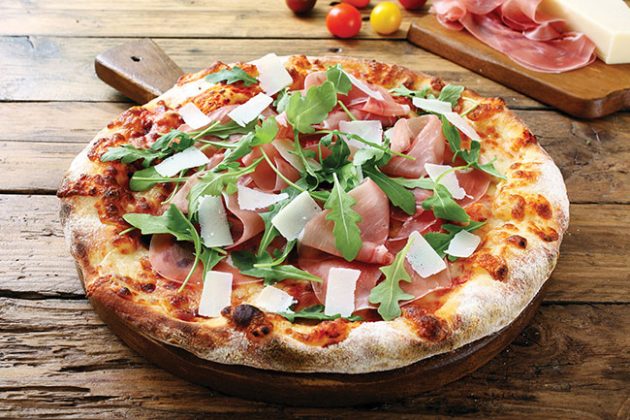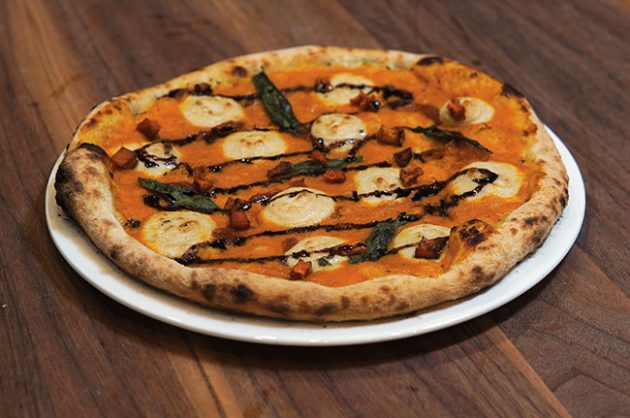
The future of the pizzeria
By Andrew Hind
Features Business and Operations TrendsThree major forces are shaping the pizza industry in the long-term
 Growing regional trends include Windsor-style, Detroit-style, Roman-style, gourmet and California-style (pictured) pizzas. Photo: Ardent Mills
Growing regional trends include Windsor-style, Detroit-style, Roman-style, gourmet and California-style (pictured) pizzas. Photo: Ardent Mills The short-term forecast for the restaurant industry in general, and for pizzerias specifically, is crystal clear: the coming winter and resurgence of COVID will result in slower traffic and leaner revenue. That’s easy to foresee.
But what about further out? What does the future of the industry look like? Put the very real problem of the pandemic aside for a moment – what forces are shaping the industry?
Casting our gaze into a crystal ball, we see several potentially transformative changes pizzeria owners should be aware of. Here are three of the more impactful.
Delivery co-ops
While food delivery apps such as Uber Eats and Skip the Dishes claim to help deliver access to more customers without investing in cars and drivers – and during the pandemic seemed to offer a way for restaurants to reach customers and remain profitable even as lockdown and restrictions were imposed – the gains have proven illusory for many pizzerias. “We needed a way to remain viable during the early months of the pandemic and thought we would give Uber Eats a try. It seemed to offer benefits,” explains Roget Yang, owner of Pizzeria Du in Toronto. “The reality, however, is that benefits have been very slim. We were essentially handing over our business, because they take up to 30 per cent for each meal (on top of the fees charged directly to the customer) and leave the restaurant with tiny margins.”
Yang had hoped that teaming up with Uber Eats would help with marketing since its platform reaches a large audience, thereby bringing in new customers. He saw little bang for his buck. “Uber Eats wants to control your branding on the platform (you can’t have logos in any of your imagery, for example) and your relationship with the customer,” Yang says. “Worse, Uber Eats can promote other restaurants, which actually results in a loss in sales. For example, we were the only vegan pizzeria in Toronto at the time and yet you couldn’t find us online. We were buried under pages of other restaurants.” What’s more, Yang lamented that food was often mangled in delivery or arrived cold.
Yang recognized that COVID was accelerating a trend in the industry that was already underway: the growing importance of delivery. With that in mind, and lamenting the issues he encountered with Uber Eats, Yang began building an alternative to delivery apps. “The challenge for a small business doing their own delivery is that most don’t have enough scale to really do it efficiently, but I reasoned that an alternative would be to join with other businesses to build economy of scale through a co-op, pooling resources to hire drivers who receive hourly salaries and insurance,” he explains. It’s worked: so far, half a dozen Toronto restaurants have joined Yang’s venture. Elsewhere in Canada, others of the same ilk are emerging as well (see, for example, “Delivery Co-op” in Canadian Pizza July/August).
“Delivery co-ops aren’t just a way forward; I believe they are the only way forward,” Yang says. “Delivery is super important, but I don’t believe delivery app services are a sustainable model long term.”

Pizzeria Du owner Roger Yang is spearheading an effort to link pizzerias through a delivery co-op. The Toronto pizzeria’s innovative menu features pumpkin apple sage pizza with fresh sage leaves. Photo: Pizzeria Du
Demand for authenticity and healthy/alternative crusts
“Pizza consumption is on the rise and there are a number of factors that are pushing this. We’re at home more; we’re returning to simple, familiar and comforting foods in times of turbulence; and there’s a rising need for purely joyful experiences. A few continuing trends that we’re seeing are the demand for authenticity and healthy/alternative crusts,” says Elaine O’Doherty, marketing manager for Ardent Mills.
At first blush the two trends sound diametrically opposed, but in fact they are tightly linked and mutually supporting.
“Authenticity is a dynamic concept – last year we saw increased demand for Neapolitan-style pizzas, authentic to Italy,” O’Doherty explains. “And while classic pizzas very much remain a staple, authenticity has evolved to also be about traceable or organic ingredients, regional varieties, seasonal and scratch-made offerings. Transparency in nutrition is a growing trend that resonates with pizza consumers. Simple recipes featuring healthier ingredients are attractive, and the more rustic, the better. The quality of pizza can also be elevated with artisan ingredients. Growing regional trends include Montreal-style pizza, Windsor-style, Detroit-style, gourmet, California-style and Roman-style pizzas.”
With the increasing demand for healthier crusts, we’re also seeing a trend towards thinner crusts. In fact, only 23 per cent of consumers said they prefer thicker crust, according to the 2020 Technomic Canadian Pizza Consumer Trend Report. O’Doherty asserts we can expect pizza operators to continue to expand their pizza crust offerings in the likes of cauliflower crusts, whole-grain, high-protein, organic and more.
“Consumer preferences are changing and growing, and new flour choices, as well as heirloom and ancient grains, open up a new world for pizza dough innovation,” she explains. “They bring new textures to crust and can also help meet the growing demand for healthy crusts and transparency in a new way. We expect to see more twists on classics in the form of gluten-free, vegan and whole-grain crusts. Crust add-ins such as quinoa, spelt and chickpea flour can help bring more nutrition, texture and new flavours to pizza recipes.”
O’Doherty says that traditional pizzas will always be a staple.
Meal kits
“While quick-service restaurant sales are forecast to decrease by only 13 per cent in 2020 compared to 2019 and, because they didn’t see as big of a decline, are forecast to return to pre-COVID levels in 2021, sales at full-service restaurants are forecast to fall by 42.5 per cent in 2020 and won’t return to pre-COVID levels until 2022. This is due to the decline in tourists, dropoff in business dining, and some consumers being reluctant to dine in as we saw before,” explains Roberto Sarjoo, Restaurants Canada’s director of marketing and communication.
The takeaway from this is that restaurants – including pizza and Italian-style restaurants that don’t focus exclusively on take-out menus ¬– need to explore alternative revenue streams. One of the more interesting is the potential of meal kits sold in partnership with grocery chains. Meal kits allow customers to bring their favourite restaurant experience into the comfort of their home (important, as 70 per cent of Canadians do not feel comfortable dining out during the pandemic). Kits are prepared by the restaurant, and come with fresh, pre-portioned ingredients and step-by-step instructions. Grocery chains, for their part, offer the infrastructure, marketing strength, reach and economy of scale to make meal kits a viable revenue proposition.
Loblaw Companies Limited, for example, has recently expanded its PC Chef meal kit direct-to-home delivery service to include fresh, ready-to-make meals from top local restaurants with next-day delivery Wednesday through Saturday. Residents in the Greater Toronto Area, for example, are now able to order their favourite dishes from more than a dozen establishments, including General Assembly Pizza. There is no commitment and no subscription required.
“Restaurants can’t stop innovating,” Sarjoo says, “and we see this innovation as an increasing share of restaurants are offering services like meal kits.”
Andrew Hind is a freelance writer from Bradford, Ont., specializing in food, history and travel. He is the author of 25 books and the proud father of one.
Print this page